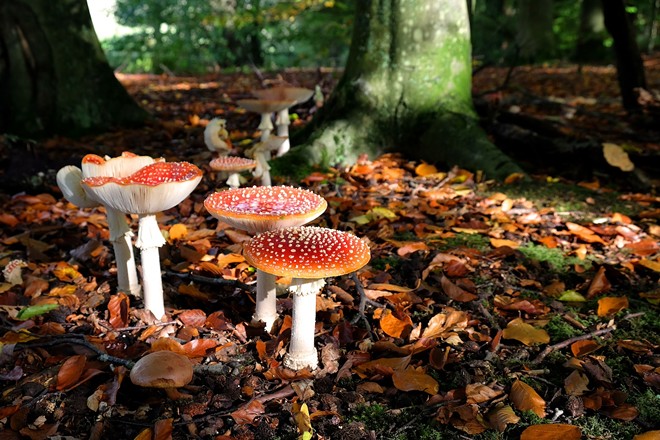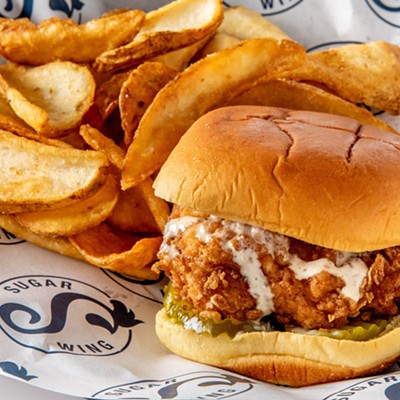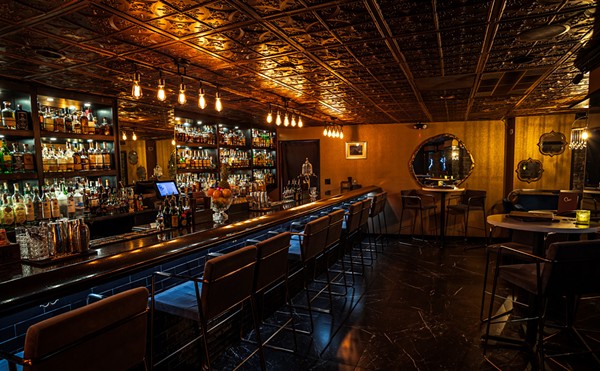Ahead of Winterdelic Tampa Bay, Christian Rasmussen discusses the legal implications of entheogenic drugs
Sponsored content.
By Teddy Duncan and Sponsored Content on Fri, Dec 15, 2023 at 3:23 pm
Psychedelics occupy a peculiar status in American culture: simultaneously garnering serious media coverage, enjoying a resurgence in medical research, and increasing public interest while remaining federally illegal. There are some substances, though, that avoid the illicit fate of a federally scheduled drug. Right here in Tampa Bay, one can go into a shop and purchase amanita muscaria, a psychoactive “magic mushroom”—along with a partially regulated galaxy of cannabis derivatives like Delta-8 and HHC.
Winterdelic, a cannabis and psychedelic wellness convention happening Dec. 16-17 at The Factory in St. Pete, is the perfect place to explore the world of psychedelics. The expo features over 50 vendors, holistic activities, music, and panels by experts and leaders in the psychedelic community. It’s sponsored by Soul Quest Ayahuasca Church of Mother Earth, which is also bringing Brother Ixã Txana from Huni Kuin to the U.S. for the very first time; Txana will give a talk at Winterdelic this weekend and be at Soul Quest Ayahuasca Church of Mother Earth for very special one night Ayahuasca ceremony.
Christian Rasmussen is the owner of MN Nice Ethnobotanicals, a retailer of entheogens based out of Minnesota, and will also be a speaker at Winterdelic. He shared insight into the legal implications of entheogenic drugs, personal healing experiences with psychedelics, and what makes amanita muscaria such a unique mushroom.
What exactly are entheogens? What distinguishes them from other drugs, such as pharmaceuticals or everyday psychotropic substances like caffeine?
Entheogens are substances, typically plants, that elicit a spiritual or mystical experience in the user. Typical pharmaceutical drugs or psychotropic substances deal with the body and the mind. Entheogens deal with the mind and the spirit. Typical drugs are matter—entheogens are energy.
Is amanita muscaria entirely legal? Why is that the case when other “magic” mushrooms are illegal?
Yep! Amanita is entirely legal in all states but Louisiana. I think there are a handful of reasons for this, but the main reason is that it hasn’t been used as much as these other substances. Amanita was never really in the forefront of the psychedelic revolution like psilocybin mushrooms and LSD were. You didn’t hear about young adults taking large doses of amanita and going to festivals, so there wasn’t the impetus to schedule it.
Amanita muscaria is a culturally iconic mushroom—the red and white mushroom with the large spotted cap is in Mario videogames, “Alice in Wonderland,” and is even an emoji. Can you briefly break down the history of amanita muscaria and how it became such a pervasive image?
This is a question we ask all the time, and there’s a lot of information still coming out. It grows on all continents besides antarctica. It was most certainly used in various shamanic and pagan rituals all over the world. In fact, its use seems to be far more prevalent than everyone initially thought, and it’s likely that aside from cannabis, it’s the most used psychoactive plant/fungi in ancient human history. There are mountains of data and evidence that support theories that amanita muscaria played an integral part in the forming of Christianity, or as the Vedic ‘drink of the Gods’ Soma. If you ask a child to draw a mushroom, whether they know anything about mushrooms or not, they will always draw the amanita muscaria. I believe that it’s ingrained in our DNA. It’s a part of our collective history and has always been a pervasive image.
Why did you decide to become an entheogen retailer? What other entheogens does MN Nice Ethnobotanicals carry?
I was going through benzodiazepine withdrawal in 2019 when I found amanita. I’ve always been fascinated by plant allies, and throughout my life up to this point I tried basically everything under the sun, except for amanita. I found some growing by my parents’ house and felt the strongest magnetism and attraction I had ever felt with a plant medicine. I found out it hits the GABA system and the glutamate system, which are the two systems that benzodiazepines damage and decided to try it. In the first week of microdosing it felt like my brain had healed 1-2 years’ worth, and I immediately realized the potential in this misunderstood mushroom. Amanita Dreamer, who is a good friend of mine, and is really the reason amanita is getting to the forefront of the collective human psyche, ended up asking me to start selling amanita here in the states because nobody reliable was doing it.
We carry a handful of other products, although not all of them are entheogens in the traditional sense. Blue lotus, Kava, Kanna, Silene capensis, Entada Rheedii, Wild Dagga are all products that we carry.
I’d always heard and read that amanita muscaria is a poisonous deliriant. Brittanica, for instance, indexes it as a poisonous mushroom. Is this correct?
This really has to do with preparation. It is true that amanita muscaria is a deliriant, it very much affects the cholinergic system, but this isn’t prevalent until one gets into the higher doses (10g+). A lot of the negative experiences come from people picking amanita and eating it in its raw form or taking much too large of a dose. Amanita really shines in microdoses or low doses, and it needs to be fully dried before consuming. I think all the negative reports and anecdotes surrounding amanita are really from being misinformed and consuming too much, or not preparing it properly.
What are the differences, pharmacologically (in terms of user-effects), between amanita and other (magic) mushrooms such as psilocybe cubensis?
Amanita muscaria hits the Gaba receptors, glutamate receptors, and cholinergic receptors. Traditional psychedelics affect the 5HT2A receptors. Pharmacologically it’s completely different groups of neurotransmitters that are being affected.
In terms of effects, amanita is completely different than traditional psychedelics. It’s really in its own field. In lower doses one can expect traditional GABAergic effects such as relaxation, peacefulness—thought processes slow down and inhibitions are lowered—but there is also this calm focus coming from the minor glutamate stimulation and then this ability to tap into higher level thinking. It seems to connect people with their true selves, all while simultaneously working on clearing past traumas and issues. It’s really a magical, and quite enjoyable, experience. Consistent microdosing seems to integrate this aspect of oneself into their day to day, which can be incredibly transformative for people.
Winterdelic, a cannabis and psychedelic wellness convention happening Dec. 16-17 at The Factory in St. Pete, is the perfect place to explore the world of psychedelics. The expo features over 50 vendors, holistic activities, music, and panels by experts and leaders in the psychedelic community. It’s sponsored by Soul Quest Ayahuasca Church of Mother Earth, which is also bringing Brother Ixã Txana from Huni Kuin to the U.S. for the very first time; Txana will give a talk at Winterdelic this weekend and be at Soul Quest Ayahuasca Church of Mother Earth for very special one night Ayahuasca ceremony.
Christian Rasmussen is the owner of MN Nice Ethnobotanicals, a retailer of entheogens based out of Minnesota, and will also be a speaker at Winterdelic. He shared insight into the legal implications of entheogenic drugs, personal healing experiences with psychedelics, and what makes amanita muscaria such a unique mushroom.
What exactly are entheogens? What distinguishes them from other drugs, such as pharmaceuticals or everyday psychotropic substances like caffeine?
Entheogens are substances, typically plants, that elicit a spiritual or mystical experience in the user. Typical pharmaceutical drugs or psychotropic substances deal with the body and the mind. Entheogens deal with the mind and the spirit. Typical drugs are matter—entheogens are energy.
Is amanita muscaria entirely legal? Why is that the case when other “magic” mushrooms are illegal?
Yep! Amanita is entirely legal in all states but Louisiana. I think there are a handful of reasons for this, but the main reason is that it hasn’t been used as much as these other substances. Amanita was never really in the forefront of the psychedelic revolution like psilocybin mushrooms and LSD were. You didn’t hear about young adults taking large doses of amanita and going to festivals, so there wasn’t the impetus to schedule it.
Amanita muscaria is a culturally iconic mushroom—the red and white mushroom with the large spotted cap is in Mario videogames, “Alice in Wonderland,” and is even an emoji. Can you briefly break down the history of amanita muscaria and how it became such a pervasive image?
This is a question we ask all the time, and there’s a lot of information still coming out. It grows on all continents besides antarctica. It was most certainly used in various shamanic and pagan rituals all over the world. In fact, its use seems to be far more prevalent than everyone initially thought, and it’s likely that aside from cannabis, it’s the most used psychoactive plant/fungi in ancient human history. There are mountains of data and evidence that support theories that amanita muscaria played an integral part in the forming of Christianity, or as the Vedic ‘drink of the Gods’ Soma. If you ask a child to draw a mushroom, whether they know anything about mushrooms or not, they will always draw the amanita muscaria. I believe that it’s ingrained in our DNA. It’s a part of our collective history and has always been a pervasive image.
Why did you decide to become an entheogen retailer? What other entheogens does MN Nice Ethnobotanicals carry?
I was going through benzodiazepine withdrawal in 2019 when I found amanita. I’ve always been fascinated by plant allies, and throughout my life up to this point I tried basically everything under the sun, except for amanita. I found some growing by my parents’ house and felt the strongest magnetism and attraction I had ever felt with a plant medicine. I found out it hits the GABA system and the glutamate system, which are the two systems that benzodiazepines damage and decided to try it. In the first week of microdosing it felt like my brain had healed 1-2 years’ worth, and I immediately realized the potential in this misunderstood mushroom. Amanita Dreamer, who is a good friend of mine, and is really the reason amanita is getting to the forefront of the collective human psyche, ended up asking me to start selling amanita here in the states because nobody reliable was doing it.
We carry a handful of other products, although not all of them are entheogens in the traditional sense. Blue lotus, Kava, Kanna, Silene capensis, Entada Rheedii, Wild Dagga are all products that we carry.
I’d always heard and read that amanita muscaria is a poisonous deliriant. Brittanica, for instance, indexes it as a poisonous mushroom. Is this correct?
This really has to do with preparation. It is true that amanita muscaria is a deliriant, it very much affects the cholinergic system, but this isn’t prevalent until one gets into the higher doses (10g+). A lot of the negative experiences come from people picking amanita and eating it in its raw form or taking much too large of a dose. Amanita really shines in microdoses or low doses, and it needs to be fully dried before consuming. I think all the negative reports and anecdotes surrounding amanita are really from being misinformed and consuming too much, or not preparing it properly.
What are the differences, pharmacologically (in terms of user-effects), between amanita and other (magic) mushrooms such as psilocybe cubensis?
Amanita muscaria hits the Gaba receptors, glutamate receptors, and cholinergic receptors. Traditional psychedelics affect the 5HT2A receptors. Pharmacologically it’s completely different groups of neurotransmitters that are being affected.
In terms of effects, amanita is completely different than traditional psychedelics. It’s really in its own field. In lower doses one can expect traditional GABAergic effects such as relaxation, peacefulness—thought processes slow down and inhibitions are lowered—but there is also this calm focus coming from the minor glutamate stimulation and then this ability to tap into higher level thinking. It seems to connect people with their true selves, all while simultaneously working on clearing past traumas and issues. It’s really a magical, and quite enjoyable, experience. Consistent microdosing seems to integrate this aspect of oneself into their day to day, which can be incredibly transformative for people.

WE LOVE OUR READERS!
Since 1988, CL Tampa Bay has served as the free, independent voice of Tampa Bay, and we want to keep it that way.
Becoming a CL Tampa Bay Supporter for as little as $5 a month allows us to continue offering readers access to our coverage of local news, food, nightlife, events, and culture with no paywalls.
Newsletters
Join Creative Loafing Tampa Bay Newsletters
Subscribe now to get the latest news delivered right to your inbox.














